The Checker Maven
Uncle Ben's Porch: Tommy's Tryout

It was getting near the end of the school year. Tommy had done well and had kept up his grades, and so Mom had allowed him to continue to spend a couple of hours every Saturday morning over on Uncle Ben's porch, learning checker lore from the old retired gentleman, who had won much-justified fame and recognition in an earlier year as a checker author, teacher, and master player.

"Well, Tommy," Uncle Ben said as they had settled into their chairs on another hot and steamy Florida morning, "pretty soon there will be the Elementary School Varsity Checker Team tryouts."
"Yes, Uncle Ben," Tommy replied, "I'm eligible for the team next year, and the tryouts take place just before the end of this year." (Of course, Uncle Ben wasn't really Tommy's uncle, but everyone called him that.) "I'm going to do my best to make the team," Tommy added.
"Well, Tommy, you've been coming right along," Uncle Ben said, "but of course your school has one of the top teams and it's going to be tough competition to win a team spot." Uncle Ben paused and reflected for a moment. "Now I know you're probably the best player in your class, but it's quite rare for someone to make Varsity the very first year that they're eligible. So it just might happen that you would have to play Junior Varsity for a season or two."
Tommy knew that Uncle Ben was trying, in his own kind and gentle way, to tell him not to be disappointed if he didn't make the team on his first try. Tommy understood just how hard that might be. But didn't Uncle Ben know just how badly Tommy wanted to make the team? After all, he'd been working on his checkers really hard this past year, paying close attention to everything that Uncle Ben taught him each Saturday morning. And besides, he'd made a point of keeping up his grades, skipping all of his favorite weeknight television programs in order to have enough time to do really good schoolwork.
Uncle Ben winked at Tommy, He did that often, but it still always caught Tommy by surprise. Uncle Ben always seemed to know just when to lighten the mood, offer a glass of his delicious homemade lemonade, or just the right word of encouragement. He really was a special kind of grownup.
"Oh yes, Tommy, I do know what you're thinking, and you have indeed turned into a fine young checkerist. But some things just take time. The wood in these fine old chairs we're sitting on didn't get seasoned over night. Some things just take time and waiting and patience. That's often hard for a young fellow to understand, but you'll see it all in time. So do your best, and whether you make the Varsity team now or a little later, I'll still be very proud of you and all that you've learned."

Before you could know it, the lemonade glasses were filled to the brim, and Uncle Ben had turned to the checkerboard, which as usual was set up with the day's work. "So, Tommy, I've got one for you here," Uncle Ben said. "It's something that will come up often in your games and who knows, you might even see it in your tryouts. Take a look."

Well, Tommy thought, Uncle Ben is hardly ever wrong--- he couldn't remember a single time, in fact, that Uncle Ben hadn't taught just the right thing at just the right time. Tommy sipped the cool, refreshing lemonade while he looked over the position Uncle Ben had laid out.
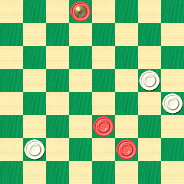
BLACK
Black to Play and Win
B:W17,13,8:BK31,10,6.
As usual, it didn't look easy at all, but Tommy knew that Uncle Ben was always giving him something that would stretch and grow his skills while still staying within his grasp... if he would just work at it hard enough. This time, Tommy was through most of his glass of lemonade before the idea came to him, and as he always did, said, "Hey Uncle Ben, how about this...." and started to move the pieces.
Can you solve the position? Whether or not you played Varsity Checkers for your school, give it a try and then click on Read More for the solution, a sample game, and no less than twenty additional examples of this theme.![]()
Computer-Aided Checker Instruction

In the world of chess, computer aids to learning are ubiquitous; virtually every chess vendor offers a bewilderingly extensive line of products, from problem collections to video tutorials to opening book trainers. Numerous other board games offer at least a few products to help build your expertise or perfect your skills. But in the world of checkers, you'd be hard pressed to find anything even remotely similar to the wide variety of choices available for other games.
However, there is an option, and checkerist Al Lyman has been working on it and refining it for a number of years. In its latest form, it's called Straight Checkers Gold and can be found at Al's Checkerworld site. Combining the original "Straight Checkers" program with two "mini" tutorial programs, the package currently sells for $59. A supplement called Formations is available for an additional $39.
Our purpose today isn't to promote Al's packages, or even to do a complete review; instead, we'd like to showcase a sample problem from each of his offerings and let you see for yourself. To our knowledge, there are no other even slightly serious computer-based checker training programs available anywhere else in the world, so in that respect, the Straight Checkers series is unique indeed.
Straight Checkers Gold consists of numerous modules and lessons, as shown in the screenshot below (click on the picture for a full-size version).
The modules and lessons can be studied in any order; there is no particular sequence or syllabus. Here is an example taken from the "sight solver" section, a grouping of 18 moderately easy problems.
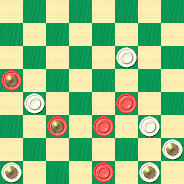
BLACK
Black to Play and Win
B:W22,16,9,K5,K4,K1:BK20,14,K11,10,2.
The additional Formations package proposes additional lessons about common checker patterns and formations, but quite a bit more is provided. Again, you can click on the screenshot below for a full-size version.
Here's an example position demonstrated in the tutorial, from the Wilderness run-up:
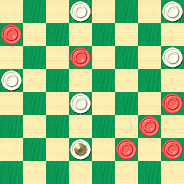
BLACK
Black to Play and Draw
B:W31,29,21,20,15,K7:B28,23,13,9,6,5.
As we said, we're not attempting a review of Al's packages. A demo version is available on Al's website, and you're best advised to take a look and see what you think. We can say, however, that there is truly nothing else like these programs to be found anywhere!
Click on Read More for the solutions to the problems above.![]()
Reed's Rattler

While the rattler similar to the one shown above can often be seen in the countryside near our Santa Fe offices, in this month's chapter of Willie Ryan's Tricks Traps & Shots of the Checkerboard, we're talking about a different kind of rattler; namely, a position that leaves you feeling, well, rattled. And, in Willie's example, who better to be the "rattlee" than that checker pedantic of yore, Harvey L. Hopkins, who, based on his writing, certainly seemed to be more than a little on the stodgy side. We can just imagine him becoming rattled indeed in the very odd position which arises below. Of course, Willie's remarks on "Chop Suey Checkers" and "Chinese checker games" might not pass muster in today's environment of political correctness, but we hope you'll allow the allusions; they're rather colorful and certainly well intended.
And now, here's Willie.
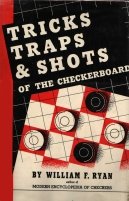
"Old-timers say that Champion James P. Reed was unbeatable when he was sober. His uncanny ability to penetrate the possibilities of play in complicated situations won him the distinction of being the greatest crossboard player of his day. Reed's main dish was 'Chop Suey Checkers,' a term he used to describe positions in which the pieces became entangled in complete confusion. The game below shows what happened to Harvey L. Hopkins, of Chicago, when Reed caught him in one of his Chinese checker games many years ago."
| 11-16 | 18-15 | 10-14 |
| 24-20 | 5-9 | 27-24 |
| 16-19 | 25-22 | 18-23 |
| 23-16 | 9-14 | 22-18---B |
| 12-19 | 29-25 | See the |
| 22-18 | 14-18 | diagram. |
| 9-13---A | 20-16 |
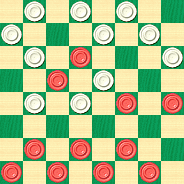
BLACK
Black to Play and Win
B:W32,31,30,28,26,25,24,21,18,16,15:B23,19,14,13,8,7,6,4,3,2,1.
A---This enigmatic move was a great favorite with Mr. Reed, and one which led opponents into a maze of complicated formations so dense that even seasoned masters often became hopelessly lost in their kaleidoscopic patterns.
B---It should be noted that 31-27 also loses here, by 6-9, 27-18,14-23,15-10 (forced), 7-14, 24-15, 23-27, 32-23, 8-11,15-8,4-20, 22-18,1-5, etc., and black wins. Wm. F. Ryan. White's best move at B is 24-20, then 7-10*---C, 16-12---D, 14-18, 21-17, 2-7, 28-24, 19-28, 26-19, 18-23, 25-21 (31-27, 23-26, 30-23, 7-11, 20-16*, 11-20,*, 23-18*, 8-11, etc., a draw), 8-11, 15-8, 4-11, 15-8, 4-11, 19-16, 11-15, 16-11, 7-16, 20-11, 15-18, 22-15, 13-22, 31-27, 10-19, 27-18, 19-23, leading to a draw. Wm. F. Ryan.
C---If 14-18 is used, white will win with 16-11*, 7-16, 20-11, 6-10 (forced; if 1-5, then 31-27, 19-24, 27-20), 15-6, 8-15, 21-17*, 1-10, 17-14, 10-17, 28-24, 19-28, 26-10, 17-26, 30-14, 13-17, 25-22, 18-25, 29-22, 4-8, 14-9. Wm. F. Ryan.
D---If 22-18 is used, then the following moves will produce a draw: 1-5, 18-9, 5-14, 31-27, 14-18, 16-12, 2-7 (8-11 draws too), 15-11, 7-16, 20-11, 8-15, 25-22, 18-25, 27-11, 10-15, 32-27, 6-10, 11-7, 13-17, 21-14, 10-17, 30-14, 3-17, 27-23, 17-22. Wm. F. Ryan. Again at D, if 16-11 is used, black will win with 14-18, 21-17, 1-5*, 20-16, 8-12, 31-27, 3-8, 27-24, 5-9, 24-20, 9-14."
Can you make your way through this one without getting rattled yourself? No need to hiss; just click on Read More to slither over to the solution.![]()
A Checker Hutzler

We're not personally acquainted with any modern-day checker analogue to the traditional pool hustler, but we know for sure that, at least in times past, such a thing did in fact exist, and no doubt exists somewhere today. Old Bennie Newell himself (your editor's grandfather) hustled checkers in his tavern in Newark, New Jersey, many decades ago, and there certainly were many others.
We don't know if the author of today's problem, a checkerist of yore named Henry Hutzler, was a hustler in anything but homonymous surname, but his composition makes a fitting entry for our Checker School series. It's deceptively simple, though not as hard as some others, and most of all, it's eminently practical and it or its like turns up in many an over-the-board contest.
BLACK
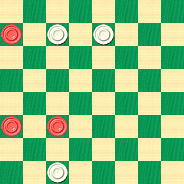
WHITE
White to Play and Win
W:W6,7,30:B5,21,22.
Forces are even, but White has a recognizable positional advantage. Is it enough to win? Mr. Hutlzer says it is, and no doubt he would have been willing to bet on it. What do you say? Make your call and then prove it before clicking on Read More to see the solution, a sample game, explanatory notes, and a most interesting quotation.![]()
Block Construction

This month, instead of the usual speed problem or stroke problem which is our traditional month opener, we're bringing you an example of a rarer species: the block problem. And this is not just any block problem; it's a block construction problem.
Having nothing at all to do with the building trades, a block construction problem challenges you to reconstruct the moves leading up to a block position. Let's take a closer look: our target position is shown below.
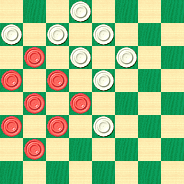
BLACK
Black to Play; White has Won
B:W31,28,27,26,23,22,18,10:B24,20,19,16,15,12,11,8.
In this position, Black is to move and the game is lost. Black is completely blocked and has no move. Your challenge is to come up with a full game, composed only of legal moves, that will lead to the block position shown. This is much more difficult than you might think, and could take an expert player an hour or more to do.
Are you up to the challenge, or are your mental processes blocked? Show your prowess as a builder by solving today's problem, then click on Read More to see how our position arose in an actual published game.![]()


